Souzan Kachbi, Salar Moazzensaffaei, Pranay Mowji: “C.I.D.E. Max”
MADE FOR CHINA. RAPID URBAN PROTOTYPING TIANJIN
Project: Made for China. Rapid Urban Prototyping Tianjin
Class: Advanced Studio, California College of the Arts, Architecture Division
Date: Spring 2011
Instructors: Mona El Khafif and Antje Steinmuller
In cooperation with UC Berkeley and TUPDI Tianjin Urban Planning and Design Institute
400 new cities are being planned in China, to be built between 2006 to 2020, increasing the country’s urbanization rate to 60%. In the process of building approximately 21.5 billion sf per year, China uses 26% of the worlds crude steel, and 47 % of the world’s cement. While the high-speed, large-scale developments have turned China into an exciting laboratory for contemporary urban and architectural ideas, the country is already the worlds largest waste generator, and one of the largest consumers of water[1]. Described as a ‘dystopian vision of instant urbanism on steroids’ [2], generic high-rise housing is erected on the raised ground of formerly vibrant neighborhoods displacing communities into self-contained homogenous bedroom developments on the periphery, and producing a highly fragmented urban landscape devoid of habitable urban space.
This massive urban growth with all its potentials and downfalls is also manifest in Tianjin, after Shenzhen and Shanghai Pudong, China’s third Economic Development Zone and already the sixth largest city in China. Tianjin is located along the Haihe River, one of the most polluted river basins in China. Confronted with acute water shortages, the government is now looking beyond multi-decade infrastructure projects towards a variety of local strategies for sustainable urban water resource management. Building on this recent reorientation, MADE FOR CHINA is looking to propose new ecological rule sets, tested via a series of new urban prototypes that link the fragmented city into a sustainable and vital urban landscape.
The area under investigation for the studio will be the former british concession, an area called Wudadao, one of nine foreign concessions fragmenting the city during its time as a treaty port. Wudadao, with its small scale fabric and green spaces, is considered a tourist attraction, and the government is looking to preserve the district’s unique identity. A 75ha area at the edge of this district is slated for redevelopment, requiring the translation of its identity into a new urban code that produces an ecologically active urban landscape, and links the disjointed city fabric.
Addressing the spatial, economical and ecological challenges of new urban China, the studio will analyze the rapid transformation of Tianjin by exploring the shifts that occurred in the last decades. The studio will concentrate on decoding local Chinese hyper urbanization in order to strategically recalibrate it towards a hybridized urban realm, generating a contemporary ecological and social alternative for Wudadao.
After a series of datascapes that visualize and critically analyze the existing paradigm shift the studio will produce a site analysis in cooperation with a thesis research studio at UC Berkeley, built on the material previously developed in the research seminar. As a group, the class will work out conceptual masterplans that will further operate as an environmental and programmatic guidelines for the block parameters, as well as for the connectivity of the site within its larger urban context. Selected contemporary urban and landscape architecture precedents that will cover hybrid programs addressing the environmental performance of the block as a self-sufficient urban unit will lead into a phase of urban prototyping at the building and block scale. The assignments will be supported through virtual Puplic Private Partnerships (Ezones) addressing the issues of water scarcity, the need of human scaled public spaces and high density. The main focus will be the development of urban and architectural typologies able to integrate and synthesize environmentally active green and blue layers, generating hybrid programmatic and systemic organizations of flexibility and high density.
China’s urbanization is inevitable, and within the next 20 years over a billion people will migrate into China’s cities [3]. This rapid growth will require a scale of real estate development never seen before through human history. Architectural and urban strategies imported from all over the world, give China the unique opportunity to develop its cities on the highest possible level of spatial quality and urban sustainability. MADE FOR CHINA signifies the current high speed mass production but also, and more importantly, potentially new product quality for new urban China. During the next decades the design community within and out side of China, has the opportunity and responsibility to create forward thinking design strategies that holistically understand cultural codes and sustainable systems through all scales. Successful models and prototypes will not only benefit China but can become precedents for the global 21st century cities.









